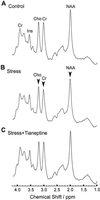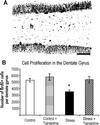Stress-induced changes in cerebral metabolites, hippocampal volume, and cell proliferation are prevented by antidepressant treatment with tianeptine
- PMID: 11675510
- PMCID: PMC60133
- DOI: 10.1073/pnas.211427898
Stress-induced changes in cerebral metabolites, hippocampal volume, and cell proliferation are prevented by antidepressant treatment with tianeptine
Abstract
Stress-induced structural remodeling in the adult hippocampus, involving debranching and shortening of dendrites and suppression of neurogenesis, provides a cellular basis for understanding the impairment of neural plasticity in the human hippocampus in depressive illness. Accordingly, reversal of structural remodeling may be a desirable goal for antidepressant therapy. The present study investigated the effect of tianeptine, a modified tricyclic antidepressant, in the chronic psychosocial stress model of adult male tree shrews (Tupaia belangeri), a model with high validity for research on the pathophysiology of major depression. Animals were subjected to a 7-day period of psychosocial stress to elicit stress-induced endocrine and central nervous alterations before the onset of daily oral administration of tianeptine (50 mg/kg). The psychosocial stress continued throughout the treatment period of 28 days. Brain metabolite concentrations were determined in vivo by proton magnetic resonance spectroscopy, cell proliferation in the dentate gyrus was quantified by using BrdUrd immunohistochemistry, and hippocampal volume was measured post mortem. Chronic psychosocial stress significantly decreased in vivo concentrations of N-acetyl-aspartate (-13%), creatine and phosphocreatine (-15%), and choline-containing compounds (-13%). The proliferation rate of the granule precursor cells in the dentate gyrus was reduced (-33%). These stress effects were prevented by the simultaneous administration of tianeptine yielding normal values. In stressed animals treated with tianeptine, hippocampal volume increased above the small decrease produced by stress alone. These findings provide a cellular and neurochemical basis for evaluating antidepressant treatments with regard to possible reversal of structural changes in brain that have been reported in depressive disorders.
Figures



Comment in
-
Depression, antidepressants, and the shrinking hippocampus.Proc Natl Acad Sci U S A. 2001 Oct 23;98(22):12320-2. doi: 10.1073/pnas.231475998. Proc Natl Acad Sci U S A. 2001. PMID: 11675480 Free PMC article. No abstract available.
References
Publication types
MeSH terms
Substances
LinkOut - more resources
Full Text Sources
Other Literature Sources
Medical

